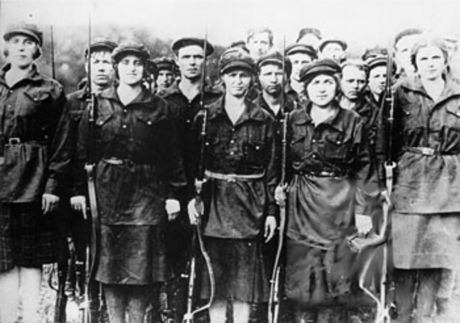Features
You are here
International Women’s Day, 1917: When Russian Women Shook the World

March 4, 2020
When thousands of women workers in Petrograd, Russia marked International Women’s Day of 1917 with a strike to demand bread, little did they know they would spark a revolution.
By the old Russian calendar, March 8 fell in February. Food was in short supply due to World War I. February 23, 1917 became the first day of the Russian Revolution, when women textile workers took to the factories, streets, and public trolleys, calling on others to join them.
They were soon joined by other factory workers, including men, and then by women in their homes. It was a groundswell that even caught revolutionary activisits in the Bolshevik Party by surprise; in fact, by deciding to strike and march the women were ignoring the advice of party leaders to “keep cool” to avoid repression.
But instead of keeping cool, Russian women went up to the soldiers' lines, took hold of their rifles and called on them to “Put down your bayonets - join us!”
Bolshevik leader Leon Trotsky would later write, “Women’s Day passed successfully, with enthusiasm and without victims. But what it concealed in itself no one had guessed even by nightfall.”
An editorial in the Bolshevik paper Pravdaa week later proclaimed “The women were the first to come out on the streets of Petrograd on their Women’s day. The women in Moscow in many cases determined the mood of the military; they went to the barracks and convinced the soldiers to come over to the side of the Revolution. Hail the women!”
In raising the cry for bread, Russian women set in motion a mass demand for three things both simple and revolutionary: peace, bread, and land. These became the three demands of the Russian revolution that echo a hundred years later: an end to war and oppression, an end to austerity, and an end to the destruction of the earth.
From women’s revolt to counter-revolution
By October workers had taken power and began to enact legislation on women’s rights still unmatched by any government today: free abortion on demand, divorce on demand, paid maternity leave, free government-funded childcare, the decriminalization of homosexuality and prostitution. The first few years of the revolutionary government saw the beginning of communal nurseries, dining rooms and socialized laundries.
It was a huge project for a fledgling state facing economic collapse, starvation and a devastating civil war after 1917, which threatened the very survival of the revolution. But the Bolsheviks did not see combating women’s oppression as something that could wait for more stable times. They believed that the very success of the revolution depended on women playing an equal role.
All of this was reversed with the rise of Stalin in the late twenties and thirties. The very unity between men and women workers upon which the revolution had relied became a threat to the counter-revolution led by Stalin and the new ruling class that emerged out of the economic devastation of the Soviet Union. Women’s newly-won rights were repealed–though not without a fight by both men and women resisting the rise of Stalinism.
Defeat was not inevitable, and the short years of revolution showed that resistance by women is key to resistance by all workers to the forces stacked against them.
Section:










